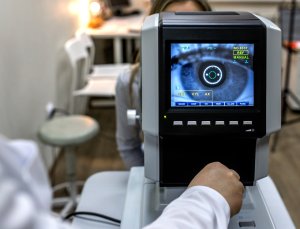What are the Signs of Macular Degeneration?

Voted Best of Berks—
eight years in a row!
Macular degeneration, specifically age-related macular degeneration (AMD), is one of the most common causes of central vision loss in adults over age 60. It affects the macula, the central part of the retina responsible for sharp, detailed vision needed for activities like reading, driving, and recognizing faces.
At Eye Consultants of Pennsylvania, our board-certified retinal specialists help patients detect and manage macular degeneration before significant vision loss occurs. Knowing the signs can make all the difference in protecting your sight.
Types of Macular Degeneration
There are two main types of AMD, and symptoms may differ depending on which one you have:
- Dry AMD (more common): Caused by gradual thinning of the macula and the presence of yellow deposits called drusen. Vision loss tends to progress slowly.
- Wet AMD (more serious): Caused by abnormal blood vessel growth under the retina, leading to leakage and rapid vision distortion or loss.
Early Signs to Watch For
Macular degeneration often develops gradually, especially in its early (dry) form, and symptoms may not be noticeable right away. However, as the condition progresses, patients may begin to experience the following:
- Blurry or Distorted Central Vision
You may notice a small blurry or dim spot in the center of your vision that doesn’t go away. Over time, this spot may grow larger or darker, making it harder to see fine details.
- Straight Lines Appear Wavy or Bent
One of the hallmark signs of AMD is metamorphopsia, where straight edges (like door frames or window blinds) appear curved or distorted. This symptom typically indicates that fluid or blood is accumulating under the retina and requires immediate attention.
- Difficulty Reading or Seeing Fine Print
You may find it increasingly hard to read books, menus, or text on a screen, even with your glasses. Words may seem faded, letters may blur together, or parts of the text may disappear altogether.
- Reduced Color Brightness or Contrast
Colors might appear less vivid or harder to distinguish. This can affect your ability to detect differences in shades or contrast, particularly in dim lighting.
- A Shadow or Blind Spot in the Central Vision
As the disease advances, a dark or blank area may appear in the center of your vision. This can interfere with face recognition, driving, or any task that requires you to focus straight ahead.
- Increased Need for Bright Light
You might find yourself turning on extra lamps to read or perform close-up tasks. While this is common with age, a sudden or noticeable increase may be related to macular degeneration.
When to See a Specialist
If you’re over 60, have a family history of AMD, or notice changes in your central vision, it’s important to get evaluated by an eye doctor as soon as possible. Early detection can help slow disease progression and preserve vision.
At Eye Consultants of Pennsylvania, we offer advanced diagnostics and treatment for all stages of AMD. From routine monitoring to intravitreal injections and other therapies, we provide personalized care based on your specific needs.
Call 1-800-762-7132 or schedule an appointment online and get expert answers about your macular health. The sooner you act, the more options you’ll have to protect your sight.
Find a Doctor
Physician information including education, training, practice location and more.
Schedule an Appointment
Call 800-762-7132 or make an appointment online.





